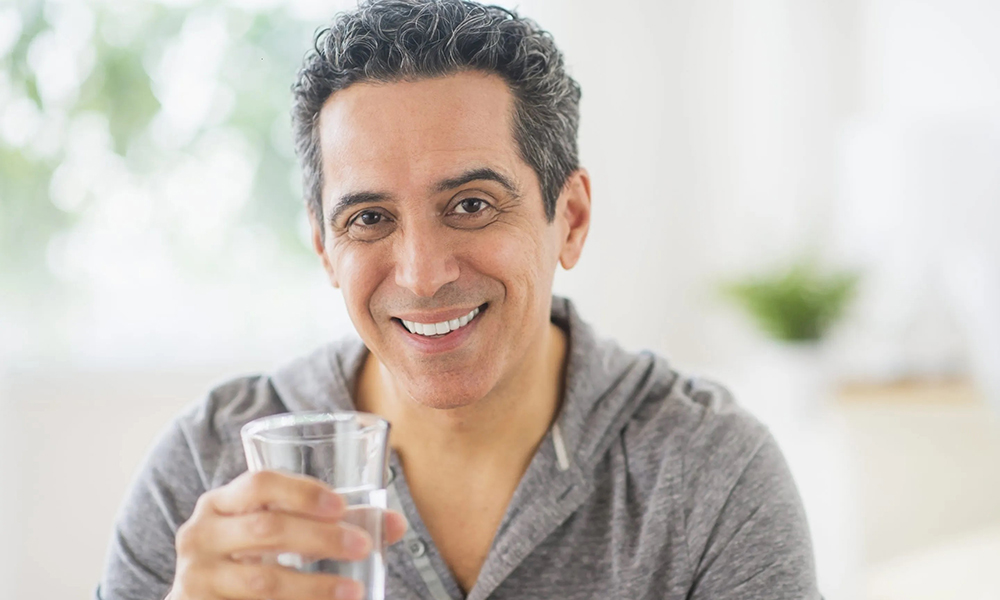
随着名牌瓶装水水瓶的出圈和 “每日一加仑水”(约3.7升) 挑战在TikTok上走红,补水成为了一种时尚,这对健康来说是个好消息,因为人体平均含水量超过60%。水几乎占到了大脑和心脏构成成分的三分之二、肺的 83%、皮肤的 64%,甚至骨骼的 31%。它参与维持生命的几乎所有生理过程。因此,如果你加入了喝水大军,这是在给自身健康添砖加瓦。
营养机构Top Nutrition Coaching注册营养师克里斯托・斯科特表示:“水是人体生存的必需物质。它帮助调节体温、运输营养物质、排出废物、润滑关节和组织,同时在维持体内电解质和体液的微妙平衡中发挥着关键作用。”
人体在呼吸、出汗、排尿以及将食物和饮料代谢为能量时,都会流失水分。如果不补充水分,健康状况会迅速走下坡路。没有食物,人可以存活长达三周甚至更久,但没有水,数天内就会死亡,毕竟身体内部依赖水的系统太多了。
斯科特说:“我喜欢把人体和地球进行类比。地球大部分由水构成,如果水量过低,我们的食物系统、森林、动物生命会怎样?这是一种多米诺效应。”
她指出,为了防止第一张多米诺骨牌倒下,我们就得多喝水。
斯科特表示:“在审视个人营养状况或生活方式的任何变化或问题时,不妨先考虑水这个因素——首先得评估饮水量。它有助于产生饱腹感,改善认知功能、情绪和身体机能,还可以预防便秘、肾结石和尿路感染等健康问题。它是个人健康的基石之一。”
归根结底:水就是生命。不过,每天应该喝多少水,才能在生存的同时健康地生活?
每天应该喝多少水?
你可能听过,这方面有一个常见的8×8经验法则,也就是每天喝八杯八盎司(约237毫升)的水。斯科特说,如果你能做到这一点已经很不错了,但可能需要做些调整。
她说:“我并不是说这个量一定有问题,而是觉得随着时间的推移,相关研究肯定有了新的发现。饮水量建议会因年龄、性别和活动量发生变化。”
饮水量建议也可能因生活环境的不同而改变。例如,如果你生活在炎热潮湿的气候中、做大量的体力活、已经怀孕或处于哺乳期,那么你每天可能需要比普通成年人更多的水。不妨寻求医生指导。
美国国家科学院、工程院和医学院建议,男性平均每日饮水量约为125盎司(约3.7升),女性约为91盎司(约2.7升)。斯科特说,可能你每天的喝水量并没有精确到这个数字,也有可能已经接近或甚至超过了,因为你还能从食物中获取水分。
她说:“人们可以从芹菜、橙子、草莓、西瓜和黄瓜等食物中获取大量水分。这些都是补水食物,实际上可以帮助补充饮水量。”
喝多少水算过量?
虽然饮水过量十分罕见,但也不是没有。这时就会出现低钠血症,也就是体内水量超过肾脏负荷,使其无法维持正常过滤速度。此时,血液中的钠含量会被稀释至危险水平,导致细胞肿胀。肾功能衰竭和充血性心力衰竭等特定疾病会增加低钠血症的患病风险,一些高强度运动员如果在运动后不补充电解质,也可能出现这种情况。
如何判断自己饮用了足够的水?
对大多数人来说,更重要的问题在于摄入足够的水分。虽然记录实际饮水量不失为一种方法,但身体本身才是判断是否缺水的最佳指标。当饮水不足时,身体会出现某些迹象。
斯科特说:“尿液颜色是判断身体是否缺水的一个很好指标。” 如果你排尿后马桶水呈淡黄色或清澈,说明不缺水。深黄色或琥珀色尿液则是身体需要水分的信号。
头痛、偏头痛、睡眠不佳、便秘、头晕以及感到头晕或困惑也可能由脱水引起。如有这方面的疑虑,那就去喝水吧。
每日饮水小贴士
如果你决心优化自身饮水情况,斯科特建议循序渐进。首先要评估自己当前的饮水量,然后设定理想中的目标。
她说:“一开始,不妨将体重的一半直接换成盎司单位,以此作为起点。因此,对于一个体重200磅(90.72kg)的人来说,我们的第一个目标是100盎司(约3升)。假设他们每天只喝20盎司水(约590毫升),那么每周增加约8到10盎司(相当于237到296毫升水),从而缓慢、稳定地达到这个目标。因为如果补水太快,人们会感觉胃胀难受。”
斯科特建议的其他实用小贴士:
尝试喝冰水或加入水果切片以增添风味。
使用较小的水瓶并多次续水,而不是用一个大水壶装满一整天的水,后者可能会让人望而却步。
将一天分成几个时间段,每个时间段设定一个小目标。这样你就能持续补水,而不是试图一次性喝完。(财富中文网)
译者:冯丰
审校:夏林
随着名牌瓶装水水瓶的出圈和 “每日一加仑水”(约3.7升) 挑战在TikTok上走红,补水成为了一种时尚,这对健康来说是个好消息,因为人体平均含水量超过60%。水几乎占到了大脑和心脏构成成分的三分之二、肺的 83%、皮肤的 64%,甚至骨骼的 31%。它参与维持生命的几乎所有生理过程。因此,如果你加入了喝水大军,这是在给自身健康添砖加瓦。
营养机构Top Nutrition Coaching注册营养师克里斯托・斯科特表示:“水是人体生存的必需物质。它帮助调节体温、运输营养物质、排出废物、润滑关节和组织,同时在维持体内电解质和体液的微妙平衡中发挥着关键作用。”
人体在呼吸、出汗、排尿以及将食物和饮料代谢为能量时,都会流失水分。如果不补充水分,健康状况会迅速走下坡路。没有食物,人可以存活长达三周甚至更久,但没有水,数天内就会死亡,毕竟身体内部依赖水的系统太多了。
斯科特说:“我喜欢把人体和地球进行类比。地球大部分由水构成,如果水量过低,我们的食物系统、森林、动物生命会怎样?这是一种多米诺效应。”
她指出,为了防止第一张多米诺骨牌倒下,我们就得多喝水。
斯科特表示:“在审视个人营养状况或生活方式的任何变化或问题时,不妨先考虑水这个因素——首先得评估饮水量。它有助于产生饱腹感,改善认知功能、情绪和身体机能,还可以预防便秘、肾结石和尿路感染等健康问题。它是个人健康的基石之一。”
归根结底:水就是生命。不过,每天应该喝多少水,才能在生存的同时健康地生活?
每天应该喝多少水?
你可能听过,这方面有一个常见的8×8经验法则,也就是每天喝八杯八盎司(约237毫升)的水。斯科特说,如果你能做到这一点已经很不错了,但可能需要做些调整。
她说:“我并不是说这个量一定有问题,而是觉得随着时间的推移,相关研究肯定有了新的发现。饮水量建议会因年龄、性别和活动量发生变化。”
饮水量建议也可能因生活环境的不同而改变。例如,如果你生活在炎热潮湿的气候中、做大量的体力活、已经怀孕或处于哺乳期,那么你每天可能需要比普通成年人更多的水。不妨寻求医生指导。
美国国家科学院、工程院和医学院建议,男性平均每日饮水量约为125盎司(约3.7升),女性约为91盎司(约2.7升)。斯科特说,可能你每天的喝水量并没有精确到这个数字,也有可能已经接近或甚至超过了,因为你还能从食物中获取水分。
她说:“人们可以从芹菜、橙子、草莓、西瓜和黄瓜等食物中获取大量水分。这些都是补水食物,实际上可以帮助补充饮水量。”
喝多少水算过量?
虽然饮水过量十分罕见,但也不是没有。这时就会出现低钠血症,也就是体内水量超过肾脏负荷,使其无法维持正常过滤速度。此时,血液中的钠含量会被稀释至危险水平,导致细胞肿胀。肾功能衰竭和充血性心力衰竭等特定疾病会增加低钠血症的患病风险,一些高强度运动员如果在运动后不补充电解质,也可能出现这种情况。
如何判断自己饮用了足够的水?
对大多数人来说,更重要的问题在于摄入足够的水分。虽然记录实际饮水量不失为一种方法,但身体本身才是判断是否缺水的最佳指标。当饮水不足时,身体会出现某些迹象。
斯科特说:“尿液颜色是判断身体是否缺水的一个很好指标。” 如果你排尿后马桶水呈淡黄色或清澈,说明不缺水。深黄色或琥珀色尿液则是身体需要水分的信号。
头痛、偏头痛、睡眠不佳、便秘、头晕以及感到头晕或困惑也可能由脱水引起。如有这方面的疑虑,那就去喝水吧。
每日饮水小贴士
如果你决心优化自身饮水情况,斯科特建议循序渐进。首先要评估自己当前的饮水量,然后设定理想中的目标。
她说:“一开始,不妨将体重的一半直接换成盎司单位,以此作为起点。因此,对于一个体重200磅(90.72kg)的人来说,我们的第一个目标是100盎司(约3升)。假设他们每天只喝20盎司水(约590毫升),那么每周增加约8到10盎司(相当于237到296毫升水),从而缓慢、稳定地达到这个目标。因为如果补水太快,人们会感觉胃胀难受。”
斯科特建议的其他实用小贴士:
尝试喝冰水或加入水果切片以增添风味。
使用较小的水瓶并多次续水,而不是用一个大水壶装满一整天的水,后者可能会让人望而却步。
将一天分成几个时间段,每个时间段设定一个小目标。这样你就能持续补水,而不是试图一次性喝完。(财富中文网)
译者:冯丰
审校:夏林
With brand-name water bottle fads and gallon-a-day water challenges trending on TikTok, hydration is in, and that’s good news for health. The average human body is more than 60% water. Water makes up almost two-thirds of your brain and heart, 83% of your lungs, 64% of your skin, and even 31% of your bones. It’s involved in almost every process that keeps you alive. So if you’ve hopped on the water-drinking bandwagon, you’re doing yourself a big solid.
“Water is essential for your body’s survival,” says Crystal Scott, registered dietitian-nutritionist with Top Nutrition Coaching. “It helps regulate your temperature, transports nutrients, removes waste, lubricates your joints and tissues, and it also plays a crucial role in maintaining the delicate balance of electrolytes and fluids in your body.”
You lose water when you breathe, sweat, urinate, and metabolize food and drink into energy. If you don’t replace that fluid, your health can go downhill, and fast. Without food, your body can keep ticking for as long as three weeks or more. But without water, you’ll die in only a few days. There’s just too many systems that depend on it.
“I like to correlate our bodies with planet earth,” says Scott. “Our earth is made up of a large percentage of water. If that amount got too low, what would happen to our food systems? Our forests? Animal life? It’s a domino effect.”
To keep that first domino from falling, she says, drink up.
“It’s the starter when looking at any form of change or issues with your nutrition or your lifestyle—assess water intake first and foremost,” says Scott. “It helps with fullness cues, it can improve cognitive function, mood, physical performance, and can prevent health problems like constipation, kidney stones, and urinary tract infections. It’s one of the foundational building blocks.”
Bottom line: Water is life. But how much should you be downing daily not just to survive, but thrive?
How many ounces of water should I drink a day?
The common rule of thumb you’ve likely heard is the 8×8 rule: Drink eight eight-ounce cups of water a day. If you’re achieving that, you’re doing well, says Scott. But it’s possible you could benefit from some adjustments.
“I don’t think that amount is necessarily wrong, but I think research over time has definitely evolved,” she says. “Water recommendations are going to vary depending on age, sex, and activity level.”
Your intake recommendation may vary based on life circumstances too. For example, if you live in a hot and humid climate, get a lot of physical activity, are pregnant, or are breastfeeding, you may need more water daily than the average adult. Your doctor can help guide you.
The National Academies of Science, Engineering, and Medicine recommends an average daily water intake of about 125 ounces for men and about 91 ounces for women. If you’re not filling up a water bottle to exactly that amount every day, you’re probably still close or even over, because you also get water from food, says Scott.
“You can get a lot of hydration from foods like celery, oranges, strawberries, watermelon, and cucumbers,” she says. “All are hydrating foods that can actually help supplement your water intake.”
How much water is too much?
Although it’s rare, it is possible to drink too much water. It’s a condition called hyponatremia, and it happens when the amount of water in your system overwhelms your kidneys and they can’t keep up with a normal filtration rate. The sodium content of your blood becomes dangerously diluted and causes your cells to swell. Certain health conditions such as kidney failure and congestive heart failure put you at higher risk of it, and some high-level athletes may experience it if they don’t replace their electrolytes after exercising.
How do I know if I’m drinking enough water?
For the majority of the population, the bigger issue is getting enough water. While it’s helpful to keep tabs on actual ounces, the best indicator of whether you’re well hydrated is your body. When you don’t get enough water, your body will show certain signs.
“Urine color is a really great indicator of hydration status,” says Scott. If your toilet water is pale yellow or clear after you pee, you’re golden. Dark yellow or amber colored urine are signs your body needs fluids.
Headaches, migraines, bad sleep, constipation, dizziness, and feeling lightheaded or confused can also be symptoms of dehydration. When in doubt, head to the spout.
Tips for getting your daily fill
If you’re committing yourself to hydration optimization, Scott recommends starting slow. First take stock of where you are, and then set a goal for where you want to be.
“Half your body weight in ounces is a great starting point,” she says. “So for someone who’s 200 pounds, our first goal would be 100 ounces. And let’s say they’re only drinking 20 ounces of fluid a day. So every week, we’d want to increase about eight to 10 ounces a week, slow and steady. Because if you do hydrate too quickly, people can feel really waterlogged.”
Other handy tips Scott suggests:
Experiment with drinking it ice-cold or adding sliced fruit to give it flavor.
Use smaller water bottles and refill them instead of filling a huge jug for the whole day, which can feel daunting to conquer.
Split your day into increments and give yourself a mini goal in each section. That way you’re keeping a steady stream of hydration going instead of trying to gulp it all in one go.






